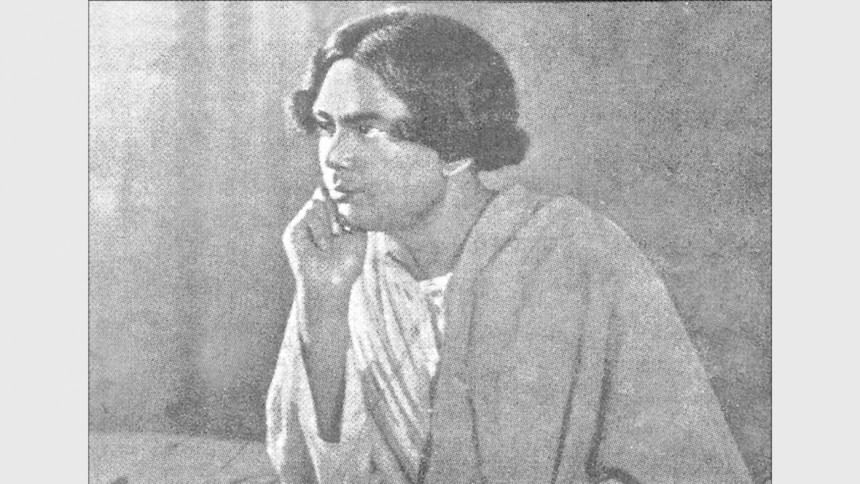Kazi Nazrul Islam: Poetry, Politics, Praxis

"[…] rub your conceptual blocs together in such a way that they catch fire."
— Karl Marx
The only major Bengali poet to have come from the rural proletariat and the first one to have raised—in public—the demand for the total independence of colonial India in 1922, Kazi Nazrul Islam (1899-1976) enacts insurrectionary ruptures and breaks with certain old traditions in Bengali poetry while inaugurating new ones. Because of his explosively anticolonial poem called "Bidrohi" (The Rebel, 1921)—characterised as it is by unprecedented rhetorical, linguistic, and even metrical energy as well as by thematic and structural novelties—it is customary to call Nazrul a "rebel poet."
But I have argued elsewhere that Nazrul is more than a rebel poet; that he is, more significantly, a revolutionary poet by his own admission—one who repeatedly mobilises the new idiom of revolution in his work. As he declares in his famous poem called "Dhumketu" (The Comet): "I come in every era/ I come again and again/ Now I've come for the great Revolution" (all translations in this piece are mine).
The French philosopher Alain Badiou maps a global tradition of revolutionary and communist poets in his book The Age of the Poets (2014), where he says: "In the last century, some truly great poets, in almost all languages on earth, have been communists. In an explicit or formal way, for example, the following poets were committed to communism: in Turkey, Nazim Hikmet; in Chile, Pablo Neruda; in Spain, Rafael Alberti, in Italy, Edoardo Sanguineti; in Greece, Yannis Ritsos; in China, Ai Qing; in Palestine, Mahmoud Darwish; in Peru, César Vallejo; and in Germany, the shining example is above all Bertolt Brecht. But we could cite a very large number of other names in other languages."
Surely one can cite Nazrul and place him in that outstanding constellation of poets Badiou mentions, given that Nazrul's two great collections of poems called Sammyabadi (The Communist) and Sarbahara (The Dispossessed/Proletariat)—published in 1925 and 1926 respectively—clearly bespeak Nazrul's commitment to "communism'" in his own creative, even indigenous ways. And one theme that persists in most of Nazrul's work is that of human emancipation while the first poem Nazrul published is called "Mukti" (Liberation).
Although a poet in the first place, Nazrul is also a musician-composer-songwriter, short story writer, novelist, playwright, and essayist. He was passionately involved in editorial journalism; he wrote both poetically and politically charged editorials, opening up a new chapter in the global history of journalism itself. He sang compulsively and even danced occasionally. He was the first Muslim director of a Bengali film, one in which he even played the part of a significant character. He was a drummer as well. And a hardcore activist, Nazrul—along with his comrades—even founded and led a short-lived political party (the Labour-Swaraj Party), writing a revolutionary manifesto on its behalf.
And, as a person, Nazrul was vibrant, gregarious, cheerful, friendly, charming. He was also known for wearing coloured shirts, writing in red ink, chewing betel-leaves, drinking tea non-stop, and for the repeated, loud bursts of his hearty laughter—laughter that simultaneously revealed his soul and his politics (I keep thinking of how the Russian novelist Maxim Gorky once described Lenin's loud laughter). In almost everything Nazrul did, poetry and politics and performance profoundly intersected, all in the interest of confronting and combatting such systems of oppression as capitalism, colonialism, racism, and patriarchy, interconnected as they are.
Indeed, when Nazrul's works began to burst onto the literary scene in the second decade of the 20th century, it was Rabindranath Tagore who was among the first ones to have recognised the poetic genius of Nazrul and hailed him as a great poet. Jibanananda Das—one of the greatest Bengali poets and slightly older than Nazrul—was initially even influenced by Nazrul himself, while Jibanananda later came to characterise Nazrul as "the people's poet and friend," reminiscent as it is of the similar characterisation of Pablo Neruda in Latin America. Buddhodeva Bose—another notable contemporary of Nazrul and an avant-garde modernist high on Western poetics and aesthetics—cared about Nazrul and even engaged with him but failed to account for his revolutionary significance in the final instance.
Nazrul was even sent to jail because of his fiercely anticolonial and anti-establishment writings; six of his books—collections of poems, prose-pieces, and songs—were banned by the British colonial government in the second decade of the 20th century! That was indeed an unprecedented event in the history of "world literature!"
Now, owing to space limitations, it is impossible to do justice to the entire range—enormous as it is—of Nazrul's work. In this short piece, however, I intend to call attention to a few areas that I think have been routinely bypassed in traditional Nazrul criticism. For instance, to begin with, not much attention has been paid to Nazrul's anti-Eurocentric conception of what is called world literature, articulated as it is in his under-engaged essay called "Bartaman Bishshya Shahittya" (Contemporary World Literature), a piece in which Nazrul deploys the metaphors of "earth" and "sky" to accentuate his unwavering commitment to the "worldliness" of poetry as such. He thinks that poetry—like theory—can certainly become a genuine material force if it grips the masses.
Connected to his premium placed on the worldliness and materiality of poetry remains Nazrul's own robust version of revolutionary internationalism and universalism—analogous to the Black Marxist CLR James' notion of a "universalism from below"—which remains opposed to the kind of trendy, derivative, aesthetics-fetishising "cosmopolitanism" represented by the likes of Buddhodeva Bose and Sudhin Dutta—the modernists of the so-called thirties. In fact, inspired by a trinity of the revolutions—the Turkish Revolution, the Irish Revolution, and, above all, the Russian Revolution—Nazrul moves in the direction of envisaging alternative, oppositional modernity, anticolonial in character and content. Unfortunately, this Nazrul remains relatively unheeded in contemporary literary criticism.
Also, isn't it instructive that Nazrul exemplarily composed "ghazals" not only in Bengali but also in Urdu, and that he even composed "bhajons" in Hindi? I think Nazrul's multi-lingual creative interventions (he knew at least six languages: Persian, Arabic, Urdu, Hindi, Sanskrit, English)—including his unprecedented contributions as a translator—have not been discussed adequately in contemporary criticism. In fact, he is by far the best translator of Persian and Arabic poetry in Bengali. He translated the great rubaiyyat of the Persian poet and polymath Omar Khayyam (1048-1131) and also the ghazals and rubiayyat of another Persian poet—Hafez (1315-1390)—while Nazrul even translated some Sufi poems of Hazrat Ali (RA). Further, Nazrul beautifully translated more than 30 Quranic suras into Bengali.
Kazi Nazrul Islam's unprecedented metrical adventures in Bengali poetry also warrant more attention than they have hitherto received. Realising that the rhythm itself is Being, and that we ourselves are multiple, sliding, traveling rhythms in space and time, Nazrul experiments with Arabic, Persian, and Sanskrit meters in his own works, producing superb rhythmic effects and even revolutionising the field of creative metrical interventions. Some of the Arabic and Persian meters Nazrul adapts in his poetry are called motaqarib, motdariq, hajaz, rajaz, and mashaqel. And the Sanskrit meters he dexterously deploys include totak, ananga shekhar, shardul brrikrita, and so on. And I think even such metrical adventures cannot be dissociated from Nazrul's anticolonial and revolutionary politics by and large.
Lastly, Kazi Nazrul Islam's poems and songs served as a genuine inspiration to our freedom fighters in 1971. In fact, our National Liberation Movement of 1971 was animated, energised, and driven by its three pronounced principles—equality, justice, and dignity—which already constituted the three abiding themes in Nazrul's entire oeuvre. Indeed, Nazrul remains resonant and relevant as long as—to use his own words in the English translation—"the sky and the air remain [filled] with the cries of the oppressed." And to honour the legacy of Nazrul is to keep combatting all forms and forces of oppression and injustice.
Dr Azfar Hussain is currently Director of the Graduate Program in Social Innovation and Associate Professor of Integrative, Religious, and Intercultural Studies at Grand Valley State University in Michigan. He is also Vice-President of the Global Center for Advanced Studies, New York, USA.

 For all latest news, follow The Daily Star's Google News channel.
For all latest news, follow The Daily Star's Google News channel. 



Comments